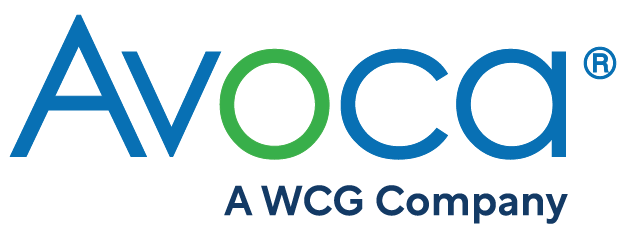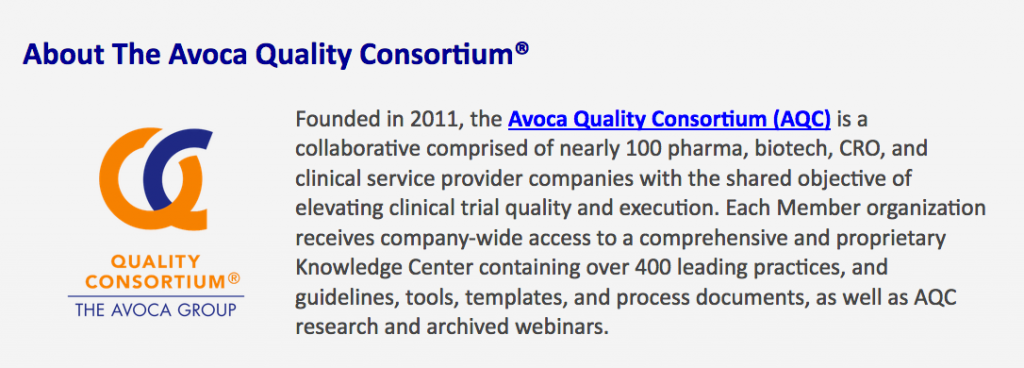Article: Biopharma Precompetitive Collaboration: Optimizing Clinical Trial Quality, Efficiency, and Excellence
By Steven B. Whittaker and Janis L. Hall, The Avoca Group
ClinicalLeader.com – April 11, 2019
Developing new, innovative pharmaceutical agents to address global health needs is becoming more complex, challenging, and costly. As the industry attempts to adapt and gain value for patients, healthcare providers, and other stakeholders, technologies, digitization, real-world data, immediate access to clinical trial data, and the adoption of wearable devices provide both opportunities and challenges. Disparate attempts to incorporate these capabilities across pharma, biotech, contract research organizations (CROs), regulators, and investigative sites create confusion and frustration while frequently adding unintended costs and quality issues.
According to former FDA Commissioner Scott Gottleib, M.D., “Efforts to streamline medical product development based on advancing science can be frustrated by legacy business models that discourage collaboration and data sharing, and the adoption of disruptive technologies that make clinical research more effective. Without a more agile clinical research enterprise capable of testing more therapies …. more efficiently and at lower total cost, important therapeutic opportunities may be delayed or discarded because we can’t afford to run trials needed to validate them.”[1]
Prioritizing Quality For Clinical Trial Success
Top-tier quality is a requirement for effectively implementing clinical trials with patient safety as a priority and for achieving valid, interpretable study data and analyses. This has profound implications for patient well-being, data integrity, and study costs. Regulators have recently intensified their focus on quality requirements for the conduct of clinical trials by issuing and endorsing the International Council of Harmonisation (ICH) guidelines known as ICH E6 (R2). These guidelines, now adopted by most major regulatory agencies, recognize the recent trends in technology that allow real-time data access and analytics, permitting active assessments of risks to patients and validity of data. The guidelines focus on early planning and documentation of quality risks to critical data and processes, ongoing monitoring of these risks with active metrics and analytics, the implementation of mitigation and contingency plans, and real-time documentation of risk management at each clinical trial stage, including within a final clinical study report.
Optimizing Value And Quality Through Precompetitive Collaborations
Precompetitive collaboration through consortia or other venues provides a means to rapidly develop new capabilities and technology while simultaneously optimizing value and quality through commonly adopted leading practices, tools, processes, and technologies across the collaborating organizations. Pre‐competitive collaboration refers to when “competitors share early stages of research that benefit all”.[2] It is increasingly accepted as a driver for enhanced efficiency and improving our grasp of increasing complexity.[3] Such collaborations are not new to the industry, but the real value and benefits from intentional precompetitive collaboration have been dramatically enhanced by the escalating costs of drug development, coupled with significant global pressures to reduce healthcare costs.
Despite long-standing industry recognition of the values of achieving results “right the first time,” including reduced costs of rescue efforts, ill-conceived perceptions of competitive pressures have frequently prevented collaborative partnerships from addressing common quality risks and issues. However, leading pharma and biotech industry executives have recognized that the achievement of quality when conducting clinical trials is not where they compete as organizations. The pharmaceutical products themselves, once placed on the market, are where competition occurs. Therefore, consortia have created collaboratives where industry-leading quality practices are being shared. Recent examples of successful precompetitive pharma sector collaborations include:
- Foundation for the NIH Biomarkers Consortium (FNIH)
- The Critical Path Institute’s Predictive Safety and Toxicology Consortium (PSTC)
- Clinical Trials Transformation Initiative (CTTI)
- The Patient‐Centered Outcomes Research Consortium (PCORI)
- TransCelerate Biopharma Inc.
- The Avoca Quality Consortium (AQC)
The overall goal of precompetitive consortia is to bring stakeholder organizations across the clinical trial ecosystem (sponsors, providers, investigative sites, technology solutions providers, regulators, and others) together, enabling targeted solutions with fewer disparate approaches that frequently lead to confusion and quality issues. The addition of technology or specialty service organizations that develop solutions for clinical trials as consortia members permits these companies to incorporate consortium-generated industry-leading practice solutions and tools into technology, digitization, and other valuable solutions.
As an example of an active consortium, the Avoca Quality Consortium (AQC), with nearly 100 pharma, biotech, provider, technical services organizations, and investigative site-facing organizations, works to develop and share industry-leading practices for the conduct of clinical trials. These include leading practices for provider qualifications, oversight of clinical trials, predictive and leading indicator metrics, risk-based or preventive approaches, inspection readiness, protocol quality, and patient engagement. These leading practices are adaptable and tailored to be fit-for-purpose for sponsors (pharma and biotech), CROs, technical service providers, or investigative sites. They are even adaptable within a sector to accommodate varied, unique needs, such as those between sponsors, from small biotech to large pharma.
Information Sharing Through Centralized, Collaborative Methods
Consortia member companies now share their experiences, challenges, and leading practice solutions via curated and anonymized online communities or knowledge centers. These permit sensitive topics, such as global regulatory inspection experiences, to be shared, thus enabling companies to enhance their ability to understand and achieve quality and compliance. The intent is to assist members to proactively build leading practices into their clinical operations and functional capabilities, including factors that are likely to benefit future inspections. These rich insights — based on actual experiences, challenges, and successes — generate interactive and engaged consortium work streams.
Examples of leading practice processes, technology, templates, and tools frequently shared in online communities or knowledge centers include the following:
- Guidelines for industry-leading practices developed through synthesizing leading practice content from consortium member companies, regulatory guidelines, and insight from industry thought leaders. The guidelines undergo peer review and frequently result in the development of practices that may not have previously existed at any individual company.
- Tools that may serve as work instructions or “how to” documents for sponsors, providers, and investigative sites (also developed through peer review processes).
- Templates that may be downloaded and adapted for fit-for-purpose use by sponsors, providers, and investigative sites.
- Collated global regulatory requirements, such as those for provider qualifications.
- Company experiences with inspections, including tips for addressing concerns and for being “inspection ready” at all times.
- Recorded educational webinars on numerous topics related to industry challenges and leading practices and quality.
- Competency assessment models that permit organizations to assess their capabilities maturity on topics such as provider oversight.
Information Sharing Through Alternative Collaborative Avenues
As already mentioned, precompetitive consortia permit very active engagement by member company staff with other like-minded, talented, experienced industry leaders across a network of companies. This opens the horizon for knowledge transfer; sharing of experiences, successes, and failures; and partnering on collaborative solutions. These engagements may occur as:
- live, in-person summits and meetings
- online community participation with direct sharing of questions, solutions, and alternatives through a “chat” construct
- participation in leadership advisory boards, where peer-to-peer insights are shared and work stream initiatives are designed and led
- peer review during the development of leading practices
- participation in live educational webinars.
Each of these venues is designed to facilitate active, engaging discussions. For example, summits are unlike traditional didactic conferences that tend to focus only on presentations and panel discussions; instead, summits enable participants to directly and frequently interact with each other.
Former FDA Commissioner Gottleib stated: “We appreciate that scientific and technical complexity is a real and ongoing challenge, but industry and academia also need to invest in and leverage these approaches and develop new incentives that reward collaboration and data sharing across the clinical research enterprise.”[4]
The pressures on the industry to innovate and to do so with quality and at low cost have led to the realization that successful, beneficial precompetitive consortia are vital for integrated solutions. The future of such opportunities is wide open and exciting for patients, sponsors, providers, and investigators alike. Organizations such as sponsors, providers, investigative sites and networks, regulators, and technology companies are encouraged to evaluate existing consortia to determine how they can benefit from innovative collaboration.
About The Authors:
Janis L. Hall is a Senior Consultant for The Avoca Group. She has over 25 years of experience in the healthcare industry with leadership roles in pharmaceutical, biotechnology, CRO, and medical diagnostic companies. Janis has been a chair, invited speaker, and panelist at numerous industry conferences. She holds an MBA from the University of Delaware and a BS in Chemistry from Towson University.
Steven B. Whittaker is a Senior Consultant for The Avoca Group. He is also a lead consultant for the pharmaceutical, biotech, and CRO industries providing expertise in project management, pharmaceutical development, clinical development, outsourcing strategies and execution plans. His experience through years of drug development leadership roles, combined with his established professional network across these industries, provides unique and valuable insights for organizational leaders.
___________________________________
[1] US FDA News and Events: 14March2019; Statement by FDA Commissioner Scott Gottlieb, M.D., on new strategies to modernize clinical trials to advance precision medicine, patient protections and more efficient product development; https://www.fda.gov/NewsEvents/Newsroom/PressAnnouncements/ucm633500.htm
[2] Weber, S. (2004) The Success of Open Source (Harvard University Press, Cambridge, MA).
[3] Hunter, J. & Stephens, S. (2010). Is open innovation the way forward for big pharma? Nature Reviews Drug Discovery. 9, pp. 87–88.
[4] Ibid. US FDA News and Events

